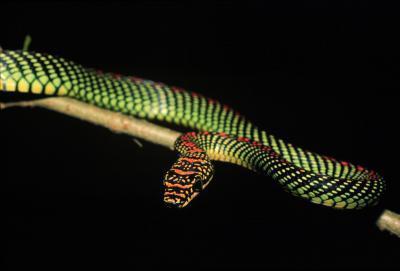We're open daily! View holiday hours
Science News
Flying Snakes
November 30, 2010

Seriously? Yes, and not just on a plane. Jake Socha, a Virginia Tech biologist, and his team recently completed a study that sheds some light on how some of these creatures fly. They reported their findings last week at the American Physical Society Division of Fluid Dynamics meeting.
Socha and his colleagues used high-speed video cameras to record Chrysepolea paradisi, one of five species of Asian tree-dwelling snakes, as they launched off a 15m (49 ft) tower! You can see the amazing footage here.
This “flying” is an important technique for these snakes. According to Live Science:
When these snakes leap, it's not to nosedive; it's to glide from tree to tree, a feat they can accomplish at distances of at least 79 feet (24 m).
Four cameras recorded the curious snakes as they glided. This allowed the scientists to create and analyze 3-D reconstructions of the animals' body positions during flight.
The researchers found that the snakes never actually achieved a proper “glide” (where the forces generated by their bodies exactly counteract gravity). They didn't exactly fall straight to the ground either. Instead, Socha says, “the snake is pushed upward—even though it is moving downward—because the upward component of the aerodynamic force is greater than the snake's weight.
“Hypothetically, this means that if the snake continued on like this, it would eventually be moving upward in the air—quite an impressive feat for a snake. But our modeling suggests that the effect is only temporary, and eventually the snake hits the ground to end the glide.”
In other words, as Buzz Lightyear would say, the snakes are simply “falling with style.”
Do the curves of the snake, or body position, mid-air affect this flying-falling? The researchers intend to find out. Stay tuned and look out!
Image: Jake Socha